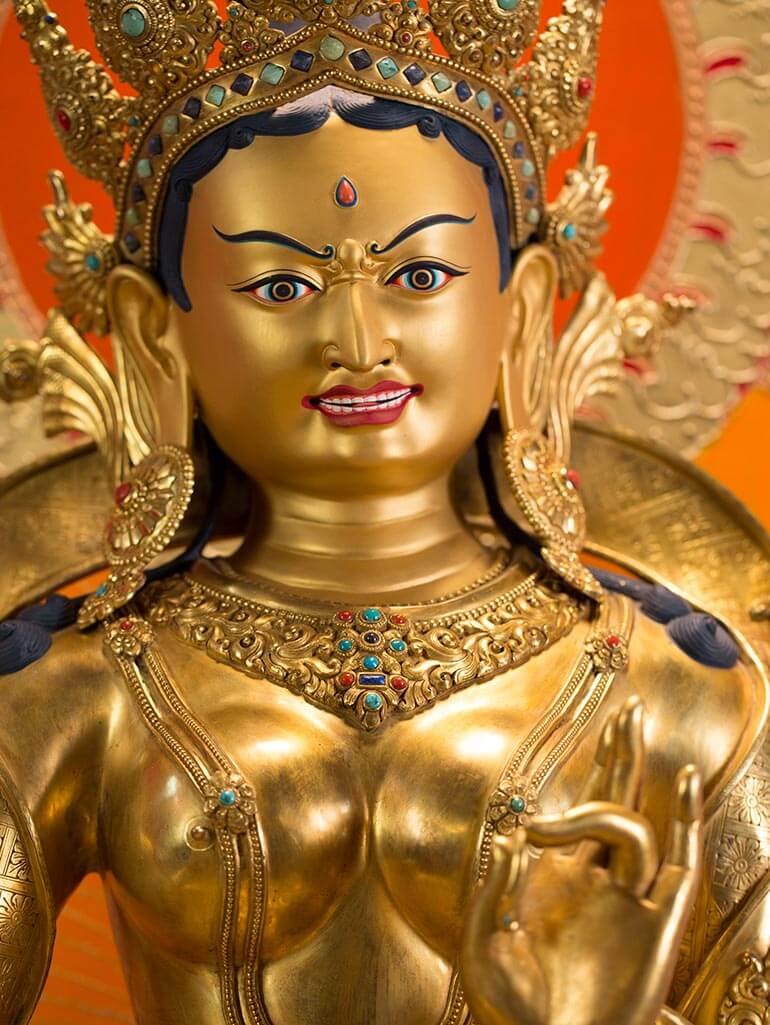Decoding 'Tara Yummy Nude': Exploring The Misconception And The Spiritual Essence Of Tara, The Buddhist Deity
When you search for something like "tara yummy nude a comprehensive look into the controversy and facts," it's almost natural to find yourself wondering what exactly lies behind such a specific combination of words. Sometimes, too, online searches can bring together terms that, in reality, belong to completely different worlds, leading to a bit of confusion. This particular search phrase, for instance, touches upon a topic that, on one hand, might suggest a public figure or a fleeting trend, yet on the other, brings to mind a deeply revered spiritual figure. So, it’s really important to sort out what's what.
You see, the internet is a vast place, and it’s very easy for ideas or names to get twisted or misunderstood. What might seem like a straightforward search can actually point to a significant disconnect between a search query and the true meaning of a subject. This happens quite a lot, especially when we talk about figures who hold deep cultural or spiritual significance.
Our aim here, then, is to clarify things. We're going to take a careful look at the actual facts surrounding Tara, a venerable figure from ancient traditions, and address the sort of "controversy" that arises when her sacred essence is inadvertently linked with unrelated or misleading terms. We'll explore who Tara truly is, what she represents, and why understanding her real meaning is so important, actually.
- Jody On Mom
- Revenge Cheating Memes
- 90 Day Fianc%C3%A9 The Other Way Cast
- Message For A Friend That Passed Away
- Wesley Kiptoo
Table of Contents
- Understanding the Search Term: 'Tara Yummy Nude' and its Context
- Who is Tara? The Venerable Mother of Liberation
- Key Aspects and Attributes of Tara, the Buddhist Deity
- The "Controversy" of Misinformation: Safeguarding Sacred Meanings
- Tara's Enduring Legacy and Guidance
- Frequently Asked Questions About Tara
Understanding the Search Term: 'Tara Yummy Nude' and its Context
When a search term like "tara yummy nude a comprehensive look into the controversy and facts" pops up, it can be a little puzzling, couldn't it? It seems to blend what might be a modern, informal reference with a name that, in many traditions, holds a lot of spiritual weight. The internet, you know, has a way of putting all sorts of words together, sometimes creating unexpected combinations. This particular phrase, in some respects, points to the challenge of distinguishing between fleeting online chatter and deeply established cultural or spiritual figures. It’s a good example of how easily a name can get pulled into contexts that are very different from its original meaning, so.
It's important to remember that search queries don't always reflect the true nature of a subject. They are, basically, just strings of words people type. In this case, the term "Tara" is actually a profound and ancient name, especially within certain spiritual paths. The other words in the query, like "yummy" or "nude," simply do not connect with the traditional, spiritual understanding of Tara at all. This disconnect is, in a way, the core of the "controversy" we're going to talk about. It's about clarifying what Tara truly represents, separating fact from any sort of online noise, and that's really what we're aiming for here.
Who is Tara? The Venerable Mother of Liberation
To really get a grip on the facts, we need to turn our attention to Tara herself, the one mentioned in ancient texts. She is, quite simply, a central and very beloved figure, particularly in Tibetan Buddhism. Known as Tārā (pronounced dölma in Tibetan) or Ārya Tārā (Noble Tara), she's also called Jetsün Dölma, which means "Venerable Mother of Liberation." She's not just a name; she's a female Bodhisattva, a being who has reached enlightenment but chooses to stay to help others find their way, too it's almost.
- Prayer To St Anthony To Find Lost Things
- Man With Most Children
- Kellie Martin Movies And Tv Shows
- How Much Did Blippi Sell For
- Snoop Steeplechase
Tara is often described as the "mother of liberation," and she represents the virtues of success in spiritual practice and life itself. She's seen as the "wisdom mother of the Buddhas," embodying the compassionate activity of all the Buddhas. Many call her "Tara the Rescuer" because she has so many aspects, each one helping beings in different ways. She's undoubtedly a powerful female deity in the Buddhist tradition, and her presence is really felt by many, very much so.
Her Name and Meanings: Star, Saviouress
Her name, Tara, means "star" in Sanskrit, and it also carries the meaning of "saviouress." This is pretty significant, actually, because she is believed to possess the ability to guide followers, much like a star guides travelers through the night. She helps people find their path, even when things seem dark or uncertain. It’s a beautiful thought, that, isn't it? She's a beacon, a source of light and direction for those who seek her guidance, and that's a powerful thing.
The Mother of All Buddhas
Tara is considered to be the "mother of all the Buddhas," which is a very high honor, you know. She's beloved for her swift, compassionate activity that really focuses on liberating beings from fear, from anxiety, and from danger. It's like she's always ready to help, always there when you need her most. This aspect of her makes her incredibly relatable and cherished by practitioners, and that's why she's so widely revered, basically.
Compassionate Activity and Liberation
Her main role, you see, is all about compassionate activity. She works tirelessly to free beings from suffering. Whether it's the fear of real-world dangers or the anxieties that trouble our minds, Tara is there to help us find freedom. She’s often associated with swift action, meaning her help comes quickly when called upon. This swiftness is a key part of her appeal, offering immediate comfort and assistance to those who are struggling. She is, in a way, a symbol of hope and immediate relief, and that’s pretty amazing.
Iconography and Representation
Tara, the supreme savioress, is typically represented as a graceful young woman with a benevolent smile, which is a lovely image. Here, Tara sits with one leg folded and the other extended, her foot resting on a small lotus. This posture is quite meaningful; the extended leg symbolizes her readiness to spring into action to help others, while the folded leg shows her meditative calm. It’s a beautiful balance, isn't it? This visual representation really captures her dual nature of wisdom and active compassion, and that’s a very important part of her identity.
She is an iconic Buddhist goddess of many colors, though she is formally associated primarily with Buddhism in Tibet, Mongolia, and Nepal. Despite this geographical focus, her influence has certainly grown, and she has become one of the most widely recognized and cherished deities across different Buddhist traditions, and even beyond, you know.
Key Aspects and Attributes of Tara, the Buddhist Deity
To give you a clearer picture, here are some key aspects and attributes of Tara, the Buddhist deity, as she is understood and revered:
| Aspect/Attribute | Description |
|---|---|
| Primary Identity | Female Bodhisattva, later revered as a Buddha. |
| Names | Tārā (Sanskrit), Dölma (Tibetan), Ārya Tārā (Noble Tara), Jetsün Dölma (Venerable Mother of Liberation). |
| Meaning of Name | "Star" or "Saviouress." |
| Role | "Mother of Liberation," "Wisdom Mother of the Buddhas," "Compassionate Activity of all the Buddhas," "Tara the Rescuer." |
| Key Virtues | Success, swift compassionate activity, liberation from fear, anxiety, and danger. |
| Representation | Graceful young woman with a benevolent smile. |
| Typical Posture | One leg folded (meditation), one extended (readiness to act), foot resting on a lotus. |
| Primary Worship | Tantrism or Vajrayana Buddhism, especially in Tibet, Mongolia, and Nepal. |
| Significance | Most powerful female deity in the Buddhist pantheon, embodiment of the divine feminine. |
The "Controversy" of Misinformation: Safeguarding Sacred Meanings
The real "controversy" here, if we can call it that, isn't about Tara herself, but rather about the way information, or misinformation, can spread online. When a sacred figure like Tara, who represents profound spiritual qualities, gets linked with terms that are completely unrelated or even disrespectful, it creates a kind of dissonance. It’s a challenge to the integrity of spiritual understanding, isn't it? This is a very important point, especially in today's fast-paced digital world, where context can so easily get lost, and that’s something we should really think about.
The facts are that Tara is a figure of immense respect and spiritual depth. She is seen as a source of comfort, guidance, and liberation for millions of people. To associate her with casual or inappropriate terms like "yummy" or "nude" is a complete misunderstanding of her essence and her role. This isn't a "controversy" in the sense of a scandal or a debate about her actions; instead, it's a concern about the potential for sacred symbols to be trivialized or misrepresented through online searches. It's a reminder that we need to be careful with how we interpret and share information, particularly when it touches upon deeply held beliefs, you know.
The Importance of Accurate Information
Getting accurate information is incredibly important, especially when it comes to spiritual or cultural topics. Misinformation can lead to skewed perceptions and, frankly, disrespect for traditions that are very meaningful to many people. When you search for something, you expect to find reliable facts, don't you? So, it’s our job to provide that clarity, to ensure that the true essence of figures like Tara is understood, rather than letting them be defined by misleading search terms. This commitment to accuracy helps maintain respect for diverse beliefs and fosters a better overall understanding of the world, basically.
Respecting Spiritual Traditions
Part of being a good global citizen, you might say, is showing respect for different spiritual traditions. Tara, as we've discussed, is a central and revered deity in Tibetan Buddhism and other Vajrayana traditions. Her imagery, her stories, and her teachings are integral to the spiritual lives of countless individuals. Understanding and respecting her true representation means acknowledging the depth and beauty of these traditions. It means recognizing that some figures are sacred and should be treated with the reverence they are accorded by their followers. This respect helps build bridges of understanding between different cultures and beliefs, and that’s a very good thing, really.
Tara's Enduring Legacy and Guidance
Tara's legacy, it’s quite clear, continues to be a powerful source of inspiration and guidance for people all over the world. Her message of swift compassion, liberation from fear, and active wisdom resonates deeply with those seeking peace and help in their lives. She embodies the divine feminine, a nurturing yet strong presence that offers solace and strength. Her teachings encourage practitioners to cultivate kindness, courage, and a readiness to help others, much like she does. It’s a timeless message, really, that continues to be very relevant even today, you know.
Her image, with one leg extended, is a constant reminder of her readiness to step into the world and assist beings. She’s not a distant, unreachable deity; she’s a compassionate mother figure, always poised to offer support. This accessibility makes her a beloved figure for daily practice and contemplation. Her presence in Buddhist traditions, especially in Tibet, Mongolia, and Nepal, is a testament to her enduring power and the profound impact she has had on spiritual paths. She is, quite simply, a beacon of hope and active love, and that’s pretty inspiring, isn’t it?
To learn more about the rich traditions surrounding Tara, you could certainly explore resources like Rigpa Wiki's entry on Tara. It’s a good place to start for deeper insights into her spiritual significance. You can also learn more about Buddhist deities on our site, and perhaps link to this page here for further exploration of spiritual figures.
Frequently Asked Questions About Tara
People often have questions about Tara, especially when encountering her for the first time. Here are some common inquiries:
Who is Tara in Buddhism?
Tara is a revered female Bodhisattva, and sometimes seen as a Buddha, particularly in Tibetan Buddhism. She's known as the "Mother of Liberation" and represents the compassionate activity of all Buddhas, helping beings overcome fear and anxiety. She's a very central figure, you know.
What does Tara represent?
Tara represents swift compassion, wisdom, and the embodiment of the divine feminine. She is a saviouress figure, believed to guide followers and liberate them from suffering, fear, and danger. She’s a powerful symbol of active help and protection, basically.
Why is Tara important to Buddhists?
Tara is incredibly important to Buddhists because she offers immediate assistance and guidance. Her compassionate nature and readiness to help make her a beloved figure for daily practice. She is seen as a source of strength and liberation, very much so, helping practitioners navigate life's challenges.
- Wrist Book Tattoos
- Tattoo David
- Brothers Keeper Tv Show
- Hope Mikaelson Real Name
- The 20 Most Dangerous Cities In America

The 21 Taras (10 to 12) - Tara Mandala

Tara | HerbaZest

La Tara y sus bondades - UNAH ALDIA